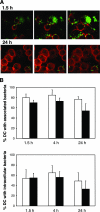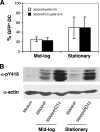Haemophilus ducreyi partially activates human myeloid dendritic cells
- PMID: 17923525
- PMCID: PMC2168323
- DOI: 10.1128/IAI.00702-07
Haemophilus ducreyi partially activates human myeloid dendritic cells
Abstract
Dendritic cells (DC) orchestrate innate and adaptive immune responses to bacteria. How Haemophilus ducreyi, which causes genital ulcers and regional lymphadenitis, interacts with DC is unknown. H. ducreyi evades uptake by polymorphonuclear leukocyte and macrophage-like cell lines by secreting LspA1 and LspA2. Many H. ducreyi strains express cytolethal distending toxin (CDT), and recombinant CDT causes apoptosis of DC in vitro. Here, we examined interactions between DC and H. ducreyi 35000HP, which produces LspA1, LspA2, and CDT. In human volunteers infected with 35000HP, the ratio of myeloid DC to plasmacytoid DC was 2.8:1 in lesions, compared to a ratio of 1:1 in peripheral blood. Using myeloid DC derived from monocytes as surrogates for lesional DC, we found that DC infected with 35000HP remained as viable as uninfected DC for up to 48 h. Gentamicin protection and confocal microscopy assays demonstrated that DC ingested and killed 35000HP, but killing was incomplete at 48 h. The expression of LspA1 and LspA2 did not inhibit the uptake of H. ducreyi, despite inactivating Src kinases. Infection of DC with live 35000HP caused less cell surface marker activation than infection with heat-killed 35000HP and lipopolysaccharide (LPS) and inhibited maturation by LPS. However, infection of DC with live bacteria caused the secretion of significantly higher levels of interleukin-6 and tumor necrosis factor alpha than infection with heat-killed bacteria and LPS. The survival of H. ducreyi in DC may provide a mechanism by which the organism traffics to lymph nodes. Partial activation of DC may abrogate the establishment of a full Th1 response and an environment that promotes phagocytosis.
Figures






Similar articles
-
Interactions of the Skin Pathogen Haemophilus ducreyi With the Human Host.Front Immunol. 2021 Feb 3;11:615402. doi: 10.3389/fimmu.2020.615402. eCollection 2020. Front Immunol. 2021. PMID: 33613541 Free PMC article. Review.
-
Inhibition of phagocytosis by Haemophilus ducreyi requires expression of the LspA1 and LspA2 proteins.Infect Immun. 2003 Oct;71(10):5994-6003. doi: 10.1128/IAI.71.10.5994-6003.2003. Infect Immun. 2003. PMID: 14500520 Free PMC article.
-
Mutations in the lspA1 and lspA2 genes of Haemophilus ducreyi affect the virulence of this pathogen in an animal model system.Infect Immun. 2003 May;71(5):2478-86. doi: 10.1128/IAI.71.5.2478-2486.2003. Infect Immun. 2003. PMID: 12704119 Free PMC article.
-
Expression of the LspA1 and LspA2 proteins by Haemophilus ducreyi is required for virulence in human volunteers.Infect Immun. 2004 Aug;72(8):4528-33. doi: 10.1128/IAI.72.8.4528-4533.2004. Infect Immun. 2004. PMID: 15271912 Free PMC article.
-
Host-pathogen interplay of Haemophilus ducreyi.Curr Opin Infect Dis. 2010 Feb;23(1):64-9. doi: 10.1097/QCO.0b013e328334c0cb. Curr Opin Infect Dis. 2010. PMID: 19918177 Free PMC article. Review.
Cited by
-
Role played by CD4+FOXP3+ regulatory T Cells in suppression of host responses to Haemophilus ducreyi during experimental infection of human volunteers.J Infect Dis. 2010 Jun 15;201(12):1839-48. doi: 10.1086/652781. J Infect Dis. 2010. PMID: 20443736 Free PMC article.
-
Determination of an Interaction Network between an Extracellular Bacterial Pathogen and the Human Host.mBio. 2019 Jun 18;10(3):e01193-19. doi: 10.1128/mBio.01193-19. mBio. 2019. PMID: 31213562 Free PMC article.
-
Interactions of the Skin Pathogen Haemophilus ducreyi With the Human Host.Front Immunol. 2021 Feb 3;11:615402. doi: 10.3389/fimmu.2020.615402. eCollection 2020. Front Immunol. 2021. PMID: 33613541 Free PMC article. Review.
-
Mechanism of human natural killer cell activation by Haemophilus ducreyi.J Infect Dis. 2009 Aug 15;200(4):590-8. doi: 10.1086/600123. J Infect Dis. 2009. PMID: 19572804 Free PMC article.
-
Haemophilus ducreyi-induced interleukin-10 promotes a mixed M1 and M2 activation program in human macrophages.Infect Immun. 2012 Dec;80(12):4426-34. doi: 10.1128/IAI.00912-12. Epub 2012 Oct 1. Infect Immun. 2012. PMID: 23027536 Free PMC article.
References
-
- Bauer, M. E., C. A. Townsend, A. R. Ronald, and S. M. Spinola. 2006. Localization of Haemophilus ducreyi in naturally acquired chancroidal ulcers. Microbes Infect. 8:2465-2468. - PubMed
-
- Ben Nasr, A., J. Haithcoat, J. E. Masterson, J. S. Gunn, T. Eaves-Pyles, and G. R. Klimpel. 2006. Critical role for serum opsonins and complement receptors CR3 (CD11b/CD18) and CR4 (CD11c/CD18) in phagocytosis of Francisella tularensis by human dendritic cells (DC): uptake of Francisella leads to activation of immature DC and intracellular survival of the bacteria. J. Leukoc. Biol. 80:774-786. - PubMed
-
- Bong, C. T. H., M. E. Bauer, and S. M. Spinola. 2002. Haemophilus ducreyi: clinical features, epidemiology, and prospects for disease control. Microbes Infect. 4:1141-1148. - PubMed
Publication types
MeSH terms
Substances
Grants and funding
LinkOut - more resources
Full Text Sources
Miscellaneous

